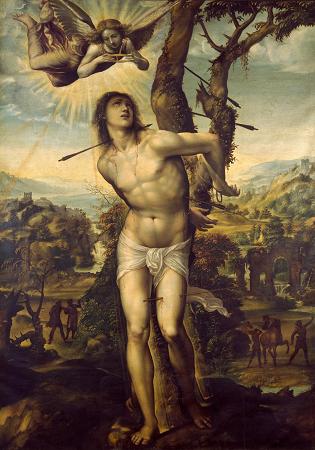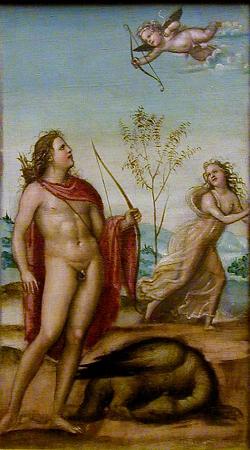Sodoma (1477 - 1549). Il Sodoma was the name given to the Italian Renaissance painter Giovanni Antonio Bazzi. Il Sodoma painted in a manner that superimposed the High Renaissance style of early 16th-century Rome onto the traditions of the provincial Sienese school; he spent the bulk of his professional life in Siena, with two periods in Rome. Giovanni Bazzi was born in Vercelli, Piedmont, in 1477. His first master was the archaic Martino Spanzotti; he also appears to have been a student of the painter Giovenone. After acquiring the strong colouring and other distinctive stylistic features of the Lombard school and-though he is not known to have travelled to Milan-somehow absorbing the superficial mannerisms of Leonardo, he travelled to Siena before 1503, perhaps at the behest of agents of the Spannocchi family, and began with fresco cycles for Olivetan monks and a series of small Ovidian ceiling panels and a frieze depicting the career of Julius Caesar for Sigismondo Chigi at Palazzo Chigi. Along with Pinturicchio, Sodoma was one of the first to practice in Siena the style of the High Renaissance. His first important works were frescoes in the Benedictine monastery of Monte Oliveto Maggiore, on the road from Siena to Rome, illustrating the life of St Benedict in continuation of the series that Luca Signorelli had begun in 1498. Gaining fluency in the prevailing popular style of Pinturicchio, Sodoma completed the set in 1502 and included a self-portrait with badgers and ravens. Sodoma was invited to Rome in 1508 by the celebrated Sienese merchant Agostino Chigi and was employed there by Pope Julius II in the Stanza della Segnatura in the Vatican. He executed two great compositions and various ornaments and grotesques in vaulted ceilings divided in feigned compartments in the antique manner that Pinturicchio had recently revived, working at the same time as Raphael. Vasari's rhetorical story that Sodoma's larger works did not satisfy the pope, who engaged Raphael to substitute a program of Justice, Poetry, and Theology is not borne out by the documents. Before October 1510 he was in Siena, where he painted the exterior of Palazzo Chigi in monochrome chiaroscuro with scenes from the Bible and from Antiquity, the first such work seen in Siena. His painting at this time began to show distinct Florentine influences, especially of Fra Bartolommeo. Called again to Rome by Chigi, in the Villa Chigi, working alongside Baldassarre Peruzzi, Sodoma painted subjects from the life of Alexander the Great: Alexander in the Tent of Darius and the Nuptials of the Conqueror with Roxanne, which some people consider his masterpiece. When Leo X became pope, Sodoma presented him with a picture of the Death of Lucretia. Leo gave him a large sum of money as a reward and created him a cavaliere. Sodoma returned to Siena and, at a later date, sought work in Pisa, Volterra, and Lucca. From Lucca he returned to Siena not long before his death on 14 February 1549. He had supposedly squandered his property and is said, without documentary support, to have died in penury in the great hospital of Siena. One of his pupils was Giomo del Sodoma. In his youth, Sodoma had married, but he and his wife soon separated. A daughter married Bartolomeo Neroni, called also Riccio Sanese or Maestro Riccio, one of Sodoma's principal pupils. Instead, he was considered by contemporaries to have been homosexual, and was known from 1512 on as Il Sodoma. Giorgio Vasari, in particular, stressed this aspect. Perhaps it was a nickname that resulted from a joke; but Bazzi seems to have used the name with pride. Some critics see in Sodoma's Madonna in the Pinacoteca di Brera the direct influence of this master. Modern criticism tends not to follow Morelli in supposing that Raphael painted Sodoma's portrait next to himself in The School of Athens, while a drawing at Christ Church is supposed to be a portrait of Raphael by Sodoma. Among his masterpieces are the frescoes, completed in 1526, in the chapel of St. Catherine of Siena painted for the church of San Domenico, depicting the saint in ecstasy, fainting as she receives the Eucharist from an angel. In the Oratory of San Bernardino, are scenes from the history of the Virgin, painted in conjunction with Pacchia and Beccafumi. These frescoes depict the Visitation and the Assumption. In San Francesco are the Deposition from the Cross and Christ Scourged. Many critics regard one or the other of these paintings as Sodoma's masterpiece. In the choir of the Pisa Cathedral is the Sacrifice of Abraham, and in the Uffizi Gallery of Florence a St. Sebastian. Some of his works, including the Holy Family now in the Pinacoteca, Siena have been mistaken for works of Leonardo da Vinci.
more...










